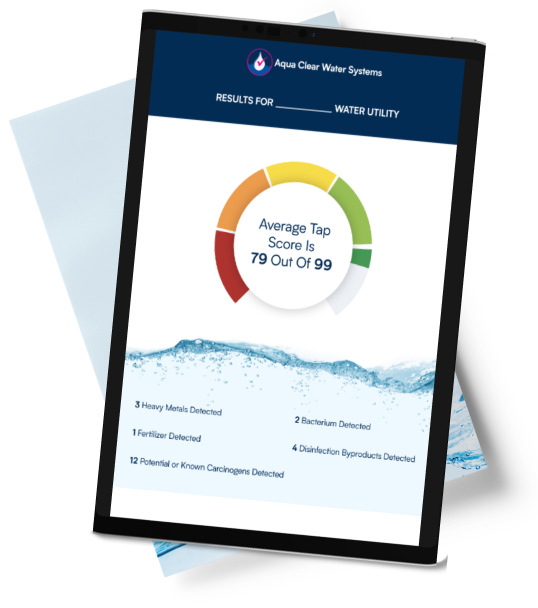Generations of Americans have had their oral health protected by the fluoridation of drinking water: it reduces the incidence of cavities and tooth decay and reduces the disparity in dental health between different social groups. In 1999, the CDC noted fluoridation as one of the great public health achievements of the 20th century (link).
People are becoming increasingly curious about the reasons behind fluoridation and wondering whether it is even necessary in the 21st century. Some are even questioning the side effects of fluoride in water.
In this article we aim to give you the information that you need to understand fluoridation and its necessity and dispel any myths you might have come across.
Why is the US Water Supply Fluoridated?
In the early 20th century, dental problems were prevalent and widespread in the United States, causing pain and financial hardship across the population. Children were especially prone to tooth loss beyond typical expectations, often losing their newly grown adult teeth due to decay.
Adults commonly suffered from toothache and painful abscesses – both of which are preventable with good dental care. It was noted by researchers at the time that in some areas, tooth decay was not so widespread, whereas in others, people tended to have stained teeth.
When they studied the composition of drinking water, it was found that there is an ideal level of fluoride to reduce the instance of tooth decay while also not causing side effects. Taking a more global look at fluoridation, it was found that millions of people worldwide consume water every day with naturally present fluoride and this afforded them a low-level of protect against dental decay and cavities.
In 1945, community water fluoridation was implemented for the first time in Grand Rapids, Michigan. The pilot program was effective in reducing tooth decay and cavities, leading to a broader uptake of artificial fluoridation across the United States.
It is important to note that water fluoridation is not a mandated process in the United States. It is not enforceable for communities to add fluoride to the drinking water supply, though in some states it is written into law to have water systems beyond a certain size provide fluoridated water to consumers.
In other areas, the water already contains fluoride at a level proven to reduce cavities and decay, so none is added.
What are the Benefits of Fluoridation?
When fluoride is introduced to the mouth (from any source) it combines with the outer layers of enamel on the teeth. This strengthens the enamel and makes the teeth more able to resist decay. Typically, fluoride reduces the risk of developing cavities by one fourth.
Fluoride can remineralize enamel, protecting the teeth from decay. It can also begin to reverse early signs of tooth decay (though you should always consult a dentist if you are experiencing signs of decay.) Consuming fluoridated water can also prevent the growth of bacteria in the mouth which lead to cavities.
Are There Side Effects of Fluoridation?
Scientific evidence is clear that water fluoridation is safe and continues to be an effective measure for improving the public health issue of dental care. At the levels added to or naturally present in community drinking water supplies, there is no evidence of harm being caused by consumption of fluoridated water.
It is far more likely for people to suffer as a result of not being exposed to fluoride in drinking water, than to suffer as a result of fluoridation.
The most common side effect of fluoride consumption is known as fluorosis: tooth discoloration due to fluoride. This presents as spots or streaks on the teeth that can range from light white to dark brown. It occurs most commonly during tooth development in children. Evidence points to artificially added fluoride having very little likelihood of causing fluorosis.
It is most commonly seen in those who consume water with a naturally occurring high level of fluoride. It is not harmful to the teeth as it is a purely cosmetic issue. It cannot be removed with tooth brushing, but a dentist may suggest specialist bleaching treatments to reduce its visibility.
If your water supply comes from a natural well and you live in an area known to have highly fluoride rich water, we recommend having a sample of the water tested so that you can be sure of the fluoride content and any associated risk of fluorosis.
What Happens if Water has too Much Fluoride?
When consumed at safe levels, fluoride is safe and an effective protection against dental decay. At high doses, however, it can be toxic (the toxicity level is dependent on a person’s weight, meaning small children are most susceptible.)
Small children should be supervised when brushing teeth to ensure they don’t swallow excessive amounts of toothpaste. It may be tempting to choose flavored toothpaste to encourage your child’s dental hygiene, but this can encourage them to swallow the toothpaste or use too much, which may increase their fluoride dose to a harmful level.
It is very difficult to reach fluoride toxicity with over-the-counter products. As previously stated, fluoride from natural sources is more likely to be a problem than that from toothpastes. If you are concerned, seek medical advice from a dentist or pediatrician without delay.
Does Bottled Water Contain Fluoride?
The composition of mineral water varies dramatically by the brand due to variations in water sources and the fact that some water companies will add fluoride to their product while others opt not to. Not all bottled water contains fluoride, and the amounts present will be variable. Some have very little while others have a recommended amount to combat tooth decay.
If you are reliant on bottled water, you should check the information provided on the label or contact the specific company for details. A dentist can advise you about appropriate levels of fluoride and supplementation if necessary.
Can Fluoride Come From Other Sources?
The main sources of fluoride are water, toothpaste and a select group of foods which includes tea, coffee and some seafoods.
The largest source of fluoride for most people is their drinking water. Municipal fluoridated water is the main source of daily fluoride intake and is responsible for most Americans getting an appropriate amount of fluoride to protect their dental health.
There are a few dietary sources of fluoride, but these make up a much smaller amount of fluoride consumed. Tea and coffee in their grown form (leaves and beans) absorb fluoride from soil, meaning that the brewed drinks are a source of fluoride.
Fluoride from the ocean can also enter the food chain through crabs, shrimps and some shellfish. You should not rely on your diet to give you an adequate daily dose of fluoride to protect your teeth.
You may notice that fluoride is a common ingredient in toothpaste, where it also works to prevent cavities and tooth decay. However, it protects the mouth differently to fluoridated water: toothpaste provides a higher concentration of fluoride at a key time of day (bedtime) while fluoridated water keeps a low concentration of fluoride in the mouth throughout the day, giving a steady level of protection.
The two work in tandem, and both together give much more protection than using just one alone.
What Is Fluoride?
Fluoride is any combination of elements containing the fluoride ion. In its elemental form, fluorine is a pale yellow, highly toxic and corrosive gas. In nature, fluorine is found combined with minerals as fluorides. Fluorine is the most chemically active nonmetallic element as well as the most reactive electro-negative ion. Because of this extreme reactivity, fluorine isn’t found as an uncombined element in nature.
One form of fluoride, hexafluorosilicic acid or hydrofluorosilic acid, is the substance used to fluoridate the majority Tennessee municipal water supplies, as well as 90% of fluoridated water across the United States.
This fluoride compound added to your water is not calcium fluoride which appears naturally in underground water sources and even sea water. Hydrofluorasilic acid (the “fluoride” they add to your water) is an industrial grade hazardous waste product generated by the air pollution-control wet scrubbing systems of the superphosphate fertilizer industry (example is Cargill Fertilizer).
How Does Fluoride Get In Our Drinking Water?
This type of fluoride is commonly contaminated with toxic metals: lead, arsenic, and trace amounts of radioactive isotopes. By law, this waste cannot be dumped into the sea. So to handle the disposal of hexafluorosilicic acid, manufactures sell these waste waste products to independent distributors who then convince municipal governments, under the impression that it prevents dental cavities, to add it to the water. If it weren’t used as an additive to water, these manufactures would have to pay millions of dollars annually to dispose of it properly. Therefore the pressure to keep fluoride listed as a healthy additive to water — is great, and political pressures to keep fluoride in the drinking water are strong.
Levels Of Fluoride In American Drinking Water
The EPA has set an enforceable regulation for fluoride, called a maximum contaminant level (MCL), at 4.0 mg/L or 4.0 parts per million. Recognizing the dangers of fluoride, they briefly note on their website, “Some people who drink water containing fluoride in excess of the MCL over may years could get bone disease (including pain and tenderness of the bones). Children aged 8 years and younger exposed to excessive amounts of fluoride have an increased chance of developing pits in the tooth enamel, along with a range of cosmetic effects to teeth.”
They then go on to say, “This health effects language is not intended to catalog all possible health effects for fluoride. Rather, it is intended to inform consumers of some of the possible health effects associated with fluoride in drinking water.”
This is an incredibly vague understatement. In new research scientists examined the relationship between fluoride intake and the hardening (calcification) of arteries. They found that fluoride consumption directly stimulates the hardening of you arteries, a condition known as atherosclerosis which is highly correlated with cardiovascular disease. Published in the January edition of the Journal of Nuclear Medicine Communications, the research highlights the fact that mass fluoride exposure may be to blame for the cardiovascular disease epidemic that takes more lives each year than cancer. In 2008, cardiovascular disease killed 17 million people.
Over 24 other studies have unanimously concluded that fluoride negatively impacts cognitive function and reduces IQ. In addition to these 24 studies focusing on cognition, over 100 animal studies show that fluoride can damage the brain and impact learning and behavior, have linked fluoride to an increase in male infertility, diabetes, kidney and liver damage, and a whole host of other health problems.
Health Effects of Fluoride In Drinking Water
Independent scientific evidence repeatedly showing up over the past 50 years reveals that fluoride allegedly shortens our life span, causes hyperthyroidism, promotes cancer and various mental disturbances, and accelerates osteoporosis (loss of bone density). It also accumulates in the human pineal gland at very high levels, reducing production of melatonin (a very important regulatory hormone), and leading to an early onset of puberty.
Fluoride accumulates in our bones and makes them more brittle and prone to fracture. The weight of evidence from animal studies, clinical studies and epidemiological studies on this is overwhelming. in animal studies fluoride at 1 ppm in drinking water was shown to increase the uptake of aluminum into the brain, a major contributing factor to Alzheimer’s disease. Also in human studies, the fluoridating agents most commonly used in the US not only increase the uptake of leak into children’s blood but also associated with an increase in violent behavior. Studies have also shown that fluoridating agents in combination with chlorinating agents such as chloramines increase the leaching of lead from brass fittings used in plumbing. There is no argument that lead even at very low levels lowers IQ in children.
The clinical Toxicology of Commercial Products, gives lead a toxicity rating of 3-4 ( 3= moderately toxic, 4= very toxic). The toxicity rating for fluoride is 4, yet the maximum contaminant level for fluoride is currently set at 4,000 ppb, over 250 times the permissible level for lead (15 ppb). In 1998, EPA scientist, whose job and legal duty it is to set MCL’s, declared that this 4ppm level was fraudulently set by outside forces in a decision omitting 90 percent of the data showing the mutagenic properties of fluoride.
The case for the fluoridation of drinking water rests simply on this ONE perceived benefit: systemic fluoride helps to prevent dental cavities in children up to the age of 12. Yet despite this alleged benefit, the CDC reported that in 2010 over 41% of US children suffer from dental fluorosis caused by excess fluoride. Even the CDC acknowledges that the purported benefit of fluoride is topical, while the risks are systemic. WATCH THIS 5 MINUTE YOUTUBE CLIP
Therefore, there is no need whatsoever to swallow fluoride to protect teeth. In young children, it merely delays the eruption of teeth, which, in one year, would eliminate the very small benefit recorded in some modern studies. Despite fluoride being added to community water supplies for over 60 years, there has never been a single randomized clinical trial to demonstrate fluoridation’s effectiveness or safety. Did you know that there is an enzyme in saliva that remineralizes soft spots in teeth using calcium in food? This enzyme is killed by fluoride and it cannot work even in the absence of fluoride if the teeth are covered by glycerin, a major component of toothpaste.
Europe Rejects Fluoridation Of Drinking Water Due To It Being Unsafe
Nearly 98% of all Western European countries have now rejected or given up water fluoridation on the grounds that it is unsafe. Yet according to the latest numbers, over 72% of American still drink water treated with fluoride.
The bottom line is that ingesting fluoride is not good for your teeth, and is undeniably toxic to your body in a myriad of ways. It is literally a poison. There is no such thing as a “low” or “optimum” level of fluoride in drinking water. Pure drinking water should contain NO fluoride whatsoever.
Removing Fluoride From Drinking Water
So how can you remove fluoride from your water? The only two treatment methods proven effective for removing fluoride are distillation and reverse osmosis. Since distillers are relatively costly ($4,000 – $5,000) and require constant maintenance, reverse osmosis is the easiest and most cost effective way to remove fluoride as well as arsenic, lead, and almost all other contaminants that are in the tap water.
The Kinetico® K5 Drinking Water Station offers the latest and most flexible RO technology available today. These systems conveniently mount. under the sink, in the crawlspace, garage, basement, and they feed a separate faucet at the sink and can also feed the refrigerator. The K5 system has an exclusive 5-stage water purification process, as well as additional features that make it the top-of-the-line choice for homeowners.
Closing Thoughts
If you are still wondering ‘is fluoride in water bad for you‘ then you can rest assured that the answer is no. Fluoride is an essential part of good dental care and its inclusion in drinking water in many areas has caused a significant downturn in the incidence of cavities and decay.
It is not added to water in all areas as it is not a federal requirement. If you are concerned about your fluoride intake, you can consult a dentist or physician who may be able to advise you on good sources of fluoride. It can be consumed through water, applied directly to the teeth by toothpaste or mouthwash, or even taken as drops or pills under the guidance of a healthcare professional.
For homeowners who want complete control over what’s in their water, investing in whole home water filter systems is an excellent solution. These systems filter every drop of water that enters your home—removing contaminants, balancing mineral levels, and ensuring that your family enjoys clean, safe, and great-tasting water straight from every tap. It’s an ideal option for those who want to reduce excess fluoride or other unwanted elements while maintaining essential minerals for health.







